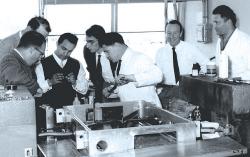The 1992 Nobel Prize in physics was awarded to Georges Charpak, France, for his invention and development of detectors in high energy physics. Since 1959 Charpak had worked at CERN, the European laboratory for particle physics situated in the canton of Geneva in Switzerland. Charpak invented the multi - wire proportional chamber at CERN. The pioneering work was published in 1968. Largely due to his work particle physicists have been able to focus their interest on very rare particle interactions, which often reveal the secrets of the inner parts of matter.
IEEE
Term Image


YearAdded:
Image Caption: CERN Experimental InstrumentationEra_date_from: 1968
2005

A pioneer in the development of electrical science, Nicholas Joseph Callan was born on 22 December 1799 in Darver, Ireland. He started the priesthood at Navan Seminary, and continued his studies at St. Patrick’s College Maynooth, where he studied natural and experimental philosophy under Dr. Cornelius Denvir. After his ordination as priest in 1823, Callan pursued his doctorate in divinity in Rome, where he became acquainted with Galvani and Volta’s work in the study of electricity, and recognized the potential to put it to practical and commercial use with powerful batteries.
YearAdded:
Image Credit: Public Domain; Produced prior to 1/1/1923Image Caption: Callan's Pioneering Contributions to Electrical Science and TechnologyEra_date_from: 1836
2006
In 1751 Benjamin Franklin published “Experiments and Observations on Electricity, Made at Philadelphia in America.”
Experiments summarized in this booklet determined the existence of positive and negative charges, and the difference between insulators and conductors. This work led to the invention of the lightning rod. Its complete construction was popularized in Poor Richard’s Almanack in 1753. This is the first practical engineering application of electricity.
A unifying theory covering static electricity, lightning, and stored charge was invented.
YearAdded:
Image Credit: Public Domain (Author's Choice)Image Caption: "Experiments and Observations on Electricity" by Benjamin Franklin, currently located at the American Philosophical Society LibraryEra_date_from: 1751
2009

"Benjamin Franklin, American electrician, printer, and diplomat, spent many years on Craven Street. He lived at No. 7 between 1772 and 1775 and at No. 36 from 1757-1762 and again from 1764-1772. During these years, Franklin popularized the study of electricity, performed experiments, and served as an adviser on lightning conductors."
(The plaque may be viewed at the Franklin house museum at 36 Craven St, London, England.)
Franklin, considered one of the founders of modern Physics, was already a famous scientist when he arrived at Craven Street in 1757.
YearAdded:
Image Credit: Courtesy Flickr/Elliott Brown (CC BY-SA 2.0)Image Caption: The Benjamin Franklin House on Craven Street in London, where Franklin lived for 16 years, and where he did much of his most famous work. Converted into a museum.Era_date_from: 1757
2003

This was a pioneering venture in mainline railroad electrification. It established single-phase alternating current as a technical and economical alternative to direct current. This concept exerted considerable influence over subsequent systems both in the United States and abroad. The major components of the system were developed by the engineering staffs of the New York, New Haven & Hartford Railroad and the Westinghouse Electric and Manufacturing Company of East Pittsburgh, Pennsylvania.
YearAdded:
Image Credit: Courtesy of the New York Public Library.Image Caption: Alternating-Current Electrification of the New York, New Haven & Hartford RailroadEra_date_from: 1907
1982

"Driven by the need to understand the characteristics of radio communication in Canada's North, Canadian researchers focused on the exploration of the earth's upper atmosphere, the ionosphere. Canada's satellite program commenced with the launch of Alouette-I on September 29, 1962. Alouette-II followed in 1965, ISIS-I in 1969, ISIS-II in 1971. The Alouette/ISIS tracking antenna serves as a reminder of Canada's contribution to this international effort in space science.
YearAdded:
Image Credit: Public Domain; NASAImage Caption: The The Alouette 1, the very first satellite constructed by CanadaEra_date_from: 1962
1993


